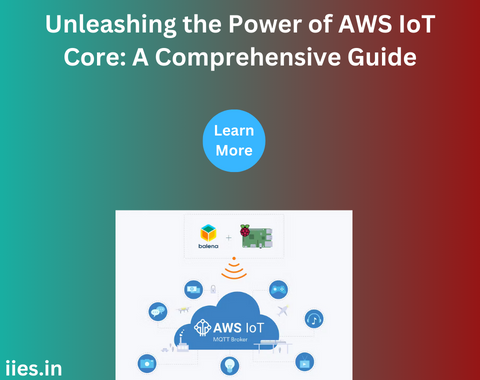
In the rapidly evolving landscape of the Internet of Things (IoT), AWS IoT Core stands out as a robust and scalable platform that empowers businesses to connect, manage, and secure their IoT devices seamlessly. As an integral part of Amazon Web Services (AWS), AWS IoT Core offers a comprehensive suite of services and features designed to simplify the complexities of IoT deployments. In this article, we delve into the key aspects of AWS IoT Core, exploring its architecture, capabilities, use cases, and the advantages it brings to organizations.
At its core, AWS IoT Core provides a reliable and secure communication platform for IoT devices. It facilitates bidirectional communication between IoT devices and the cloud, enabling seamless data exchange and management. The platform’s architecture is built to handle massive-scale device fleets, making it suitable for a wide range of industries, including manufacturing, healthcare, agriculture, and smart cities.
At its core, AWS IoT Core provides a reliable and secure communication platform for IoT devices. It facilitates bidirectional communication between IoT devices and the cloud, enabling seamless data exchange and management. The platform’s architecture is built to handle massive-scale device fleets, making it suitable for a wide range of industries, including manufacturing, healthcare, agriculture, and smart cities.
1. Device Registry and Shadow
One of the foundational components of AWS IoT Core is the Device Registry, which acts as a central repository for managing information about connected devices. Each device is assigned a unique identity, allowing for easy tracking and management. Additionally, AWS IoT Core employs a concept called “Device Shadow,” providing a virtual representation of each device’s state. This allows applications to interact with the virtual device, making it a powerful tool for managing device state and handling intermittent connectivity issues.
2. Secure Communication
Security is paramount in IoT deployments, and AWS IoT Core addresses this concern with robust security features. It supports industry-standard encryption protocols such as TLS (Transport Layer Security) and integrates with AWS Identity and Access Management (IAM) for access control. Device authentication is handled through X.509 certificates or custom authentication mechanisms, ensuring that only authorized devices can communicate with the IoT Core.
II. Key Features and Capabilities
AWS IoT Core offers a plethora of features and capabilities that contribute to its versatility and effectiveness in managing IoT deployments.
1. Device Management
AWS IoT Core simplifies the task of onboarding and managing devices at scale. With the Device Management feature, organizations can remotely update device firmware, track device health, and monitor performance. This not only streamlines operations but also reduces the need for manual intervention, making it feasible to manage thousands or even millions of devices efficiently.
2. Rules Engine
The Rules Engine is a powerful feature that allows users to define rules for processing and acting on data generated by IoT devices. By specifying SQL-like queries, users can filter, transform, and route data to various AWS services, facilitating real-time analytics, storage, and integration with other AWS offerings. This flexibility enhances the adaptability of AWS IoT Core to diverse use cases.
3. Integration with Other AWS Services
AWS IoT Core seamlessly integrates with a wide range of AWS services, extending its capabilities and enabling users to build end-to-end IoT solutions. For example, data from IoT devices can be stored and analyzed using Amazon S3 and Amazon Kinesis, while AWS Lambda can be used for serverless computing to process data in real-time.
III. Use Cases and Applications
AWS IoT Core finds application across various industries, driving innovation and efficiency in diverse use cases.
1.Smart Manufacturing
In manufacturing, AWS IoT Core enables the creation of smart factories by connecting and monitoring equipment and machinery. Predictive maintenance becomes feasible as devices can communicate their status in real-time, allowing organizations to schedule maintenance before failures occur. This results in reduced downtime and increased overall efficiency.
2. Healthcare IoT
In the healthcare sector, AWS IoT Core plays a crucial role in connecting medical devices, monitoring patient health, and ensuring the seamless flow of data between devices and healthcare systems. This facilitates remote patient monitoring, personalized healthcare, and efficient management of medical resources.
3. Smart Cities
For smart cities, AWS IoT Core provides a foundation for managing diverse IoT devices such as sensors, cameras, and connected infrastructure. This enables the implementation of intelligent urban planning, traffic management, and environmental monitoring, contributing to enhanced livability and sustainability.
IV. Advantages of AWS IoT Core
1. Scalability
AWS IoT Core is designed to scale horizontally, accommodating a growing number of devices seamlessly. Whether an organization starts with a handful of devices or plans to deploy millions, the platform can scale to meet the requirements, ensuring a consistent and reliable performance.
2. Global Reach
With AWS’s extensive network of data centers across the globe, AWS IoT Core provides low-latency communication and data processing. This global reach is essential for organizations with distributed IoT deployments, ensuring optimal performance regardless of the geographical location of devices.
3. Cost-Efficiency
AWS IoT Core follows a pay-as-you-go pricing model, allowing organizations to pay only for the resources they consume. This cost-efficiency is particularly beneficial for businesses of all sizes, as it eliminates the need for upfront investments and provides flexibility in adapting to changing requirements.
As the IoT landscape continues to evolve, AWS IoT Core stands out as a powerful and flexible platform for connecting and managing IoT devices at scale. Its robust architecture, extensive features, and seamless integration with other AWS services make it a preferred choice for organizations seeking to harness the potential of IoT. Whether in manufacturing, healthcare, or smart cities, AWS IoT Core empowers businesses to build innovative and efficient IoT solutions, laying the groundwork for a connected and intelligent future.
Indian Institute of Embedded Systems – IIES